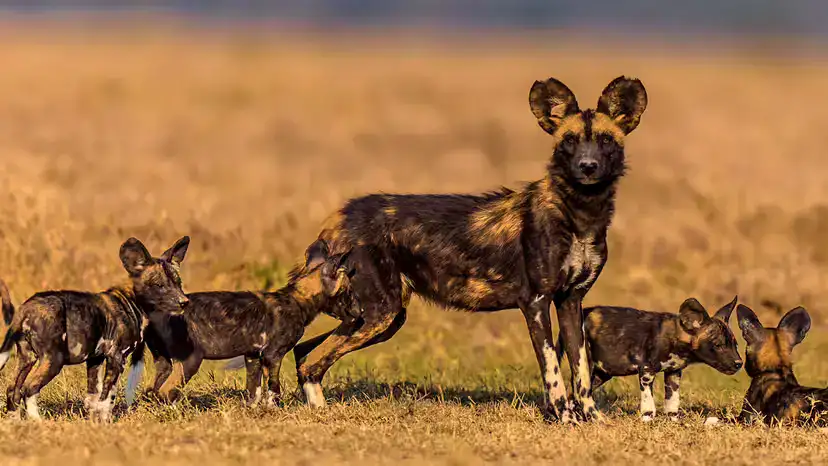Scientific name: Lycaon pictus (monotypic genus Lycaon)
Common names: African wild dog, painted wolf, Cape hunting dog
Family: Canidae (dog family)
IUCN status: Endangered
Shoulder height: ~60–75 cm (24–30 in)
Weight: ~16–30+ kg (35–66 lb)
Distinctive traits: Only four toes per foot (no dewclaw); huge rounded ears for heat loss; uniquely “painted” coat (no two dogs look alike)

Often mistaken for hyenas by newcomers, African wild dogs are true canids—more closely related to wolves and domestic dogs than to hyenas. Their long legs, lean bodies, and oversized ears are built for long-distance chases on hot savannas. Each dog’s patchwork of black, yellow, and white is as individual as a fingerprint.
Feet: Four toes (other canids have five on the forefoot).
Ears: Broad, rounded “satellite dishes” that radiate heat and enhance hearing.
Coat: “Painted” patterns unique to each individual.
Gait: Light, energy-efficient trot; capable of sustained high-speed pursuits.
Historically widespread across sub-Saharan Africa, the species is now largely restricted to southern and parts of eastern Africa (e.g., Botswana, Namibia, Zimbabwe, South Africa, Mozambique, Zambia, Tanzania).
They favor open savannas, woodland mosaics, and semi-arid shrublands—landscapes where long sightlines and room to run matter.
Wild dogs are cooperative pursuit hunters that target medium-sized antelopes (e.g., impala, gazelle, duiker, steenbok, kudu calves). They also take hares and, opportunistically, other small prey.
Why they’re so effective
Teamwork: Tight coordination, role-switching, and relay-style chasing.
Endurance: They run prey to exhaustion rather than relying on a single ambush.
Success rate: Among the highest of any large carnivore, especially when packs are intact and habitat is open.
After a kill, adults regurgitate meat for pups, nursing females, and injured packmates—an extreme form of social care unusual among large carnivores.
Core unit: A dominant breeding pair (alpha male & female) plus their offspring and unrelated helpers.
Cooperative breeding: Nonbreeders guard dens, bring food, and babysit.
Dispersal: Typically same-sex siblings leave together to find mates; in many areas females disperse farther while males are more philopatric (stay nearer to natal range).
Communication: Yips, hoots, twittering contact calls, body posture, and scent marking coordinate movement and bonding.
Pups & denning: Litters are large (often 6–16 pups). Dens are commonly abandoned aardvark or warthog burrows. The entire pack provisions pups and the lactating female.
1) Habitat loss & fragmentation
They need huge home ranges (hundreds to thousands of km²). Even “large” reserves can be all edge from a wild dog’s perspective, pushing packs across boundaries where they encounter livestock, roads, and people.
2) Human–wildlife conflict
Persecution following real or perceived livestock predation; snaring intended for bushmeat frequently catches wild dogs.
3) Infectious disease
Rabies and canine distemper transmitted by domestic dogs can wipe out small, isolated packs.
4) Roads & fences
Vehicle strikes and barriers that disrupt movements, reduce gene flow, and complicate hunting routes.
Consequence: Small, isolated packs are more vulnerable to disease outbreaks, inbreeding, and random events.
Landscape connectivity: Wildlife corridors between parks; permeability in fence design where feasible.
Dog vaccination belts: Mass vaccination of domestic dogs around protected areas to curb rabies/distemper spillover.
Snare-removal patrols & community rangers: Reduce non-target mortality and build local stewardship.
Conflict mitigation: Guarding, kraals/bomas, compensation/insurance schemes, targeted deterrents.
Monitoring: Photo-ID (coat patterns), GPS collars, and citizen-science sightings inform adaptive management.
| Feature | African Wild Dog (Lycaon pictus) | Spotted Hyena (Crocuta crocuta) |
|---|---|---|
| Taxonomy | Canid (dog family) | Hyenid (cat-like carnivores) |
| Toes | 4 per foot (no dewclaw) | 4, but different foot structure |
| Ears | Large, round | Rounded but proportionally smaller |
| Build | Long-legged, lean | Heavier forequarters, sloping back |
| Hunting | Cooperative chases; high success | Endurance hunters & kleptoparasites |
| Sociality | Cooperative breeders; regurgitation feeding | Matriarchal clans; no regurgitation for adults |
Are they dangerous to people?
Serious incidents are rare. They avoid humans and focus on wild prey. Conflict usually stems from proximity to livestock.
How far do packs travel?
Packs can cover 10–20+ km per day, shifting seasonally with prey and denning needs.
How do they communicate over distance?
With high-pitched “hoo” calls, yips, and scent marks that help regroup widely ranging members.
What’s the biggest threat right now?
A three-way squeeze: fragmented habitat, disease from domestic dogs, and snaring/persecution where packs intersect with people.
Can populations recover?
Yes—when connected habitat, disease control, and conflict mitigation are in place. Packs reproduce well if they can persist safely.
animal tags: african wild dog
We created this article in conjunction with AI technology, then made sure it was fact-checked and edited by a Animals Top editor.